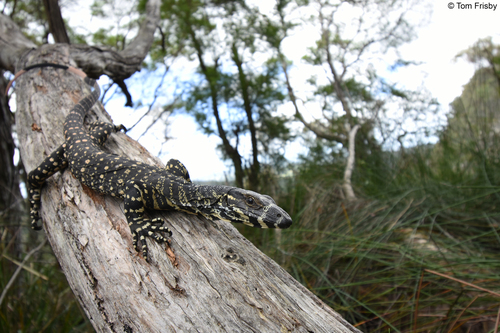
Lace Monitor
The Lace Monitor (Varanus varius) boasts striking black and white patterns, thriving in Australia's forests. This formidable carnivore, reaching lengths of up to 2 meters, plays a vital ecological role as a scavenger. Its keen sense of smell aids in locating prey, making it a fascinating predator.
10-15 years
Lifespan
19.958 kg
Weight
Length: 1.52 - 1.83 m
Size
Grey, Yellow, Blue, Black, Cream
Color
4-5 years
Age of Sexual Maturity
Medium
Aggression
Least Concern
Conservation Status
Stable
Population Trend
Characteristics
The Varanus varius, commonly known as the Lace Monitor or Lace Goanna, is a large lizard native to eastern Australia. It thrives in varied habitats including forests, woodlands, and coastal regions. Known for its striking patterned skin, it can grow up to 2 meters long. This species is carnivorous, preying on insects, small mammals, and birds. It plays a crucial ecological role as a scavenger, helping to control populations of smaller animals and aiding in decomposition.
Distribution Range of the Lace Monitor
Varanus varius, commonly known as the Lace Monitor, is native to Australia. Its geographical distribution predominantly includes the eastern and southeastern parts of the continent, specifically in Queensland, New South Wales, Victoria, and parts of South Australia.
Lace Monitor's Habitat
Environmental Conditions
The Lace Monitor typically inhabits a variety of environments ranging from coastal forests and woodlands to dry inland regions. It is often found in areas with a mix of open spaces and dense vegetation, such as eucalyptus forests and rainforests. The climate in these regions can vary from temperate to subtropical, with distinct seasonal variations in temperature and rainfall.
Ecological Niche
As a large terrestrial and arboreal lizard, the Lace Monitor occupies a significant ecological niche as both a predator and scavenger. It feeds on a diverse diet that includes small mammals, birds, insects, and carrion. The species is well adapted to climbing and often seeks refuge or nests in tree hollows. Lace Monitors play an essential role in their ecosystems by controlling prey populations and contributing to the decomposition process of organic matter.
Copyright @ Nature Style Limited. All Rights Reserved.
 English
English